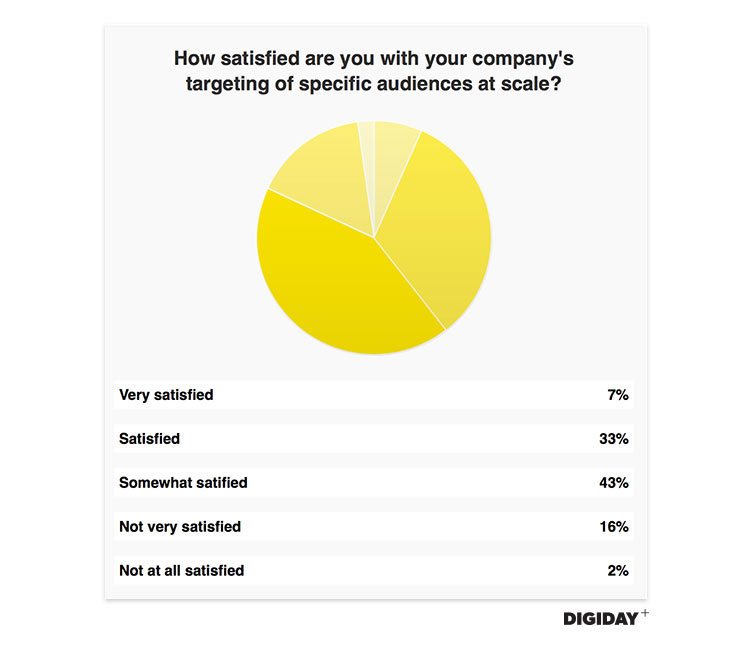Digiday Research: 40 percent of marketers approve of their audience-targeting abilities

This research is based on unique data collected from our proprietary audience of publisher, agency, brand and tech insiders. It’s available to Digiday+ members. More from the series →
Digiday’s “Research in brief” is our newest research installment designed to give you quick, easy and digestible facts to make better decisions and win arguments around the office. They are based on Digiday’s proprietary surveys of industry leaders, executives and doers. See our earlier research on the publisher pivot to video here.
Certain topics in advertising seem ever-present, like ad fraud, transparency and audience targeting, to name a few.
Audience targeting has been a critical component of marketing since the dawn of advertising. Despite this, most marketers remain lukewarm about their company’s audience-targeting capabilities.
In a recent survey of industry leaders at the Digiday Programmatic Marketing Summit, we found that only 40 percent of respondents were satisfied with their ability to target audiences at scale. Marketers seemed generally indifferent about their scaled audience-targeting capabilities. Only 9 percent indicated they were on the extremes of very satisfied or unsatisfied. 
The data and insights powering audience targeting have come a long way with the proliferation of programmatic marketing and enhanced tracking tools. So why aren’t marketers more enthused about their targeting capabilities at scale?
The fact that more than half of all audience-based campaigns fail to reach their target audience probably has something to do with it. A report by Marketing Week citing Nielsen research in the U.K. found that 53 percent of digital campaigns aren’t being viewed by the intended user.
Audience targeting has been thrust into the spotlight following ProPublica’s revelations about hate groups targeted through Facebook’s ad platform. Despite the negative press audience targeting has received, several vendors and platforms such as Taboola, comScore and YouTube recently launched new audience-targeting tools.
Ad position: web_incontent_pos1
Marketers might have to wait a while until they can say they’re completely satisfied with their audience-targeting abilities. The upcoming enforcement of the General Data Protection Regulation could potentially limit the data that marketers can access to measure campaign effectiveness. With questions surrounding campaign performance, marketers may flee programmatic-based audience-targeting campaigns in favor of other tactics. Brand-safety concerns also will play a role as companies no longer chase audiences but focus instead on advertising on select trusted sites.
More in Media

NewFronts Briefing: Samsung, Condé Nast, Roku focus presentations on new ad formats and category-specific inventory
Day two of IAB’s NewFronts featured presentations from Samsung, Condé Nast and Roku, highlighting new partnerships, ad formats and inventory, as well as new AI capabilities.

The Athletic to raise ad prices as it paces to hit 3 million newsletter subscribers
The New York Times’ sports site The Athletic is about to hit 3 million total newsletter subscribers. It plans to raise ad prices as as a result of this nearly 20% year over year increase.

NewFronts Briefing: Google, Vizio and news publishers pitch marketers with new ad offerings and range of content categories
Day one of the 2024 IAB NewFronts featured presentations from Google and Vizio, as well as a spotlight on news publishers.
Ad position: web_bfu